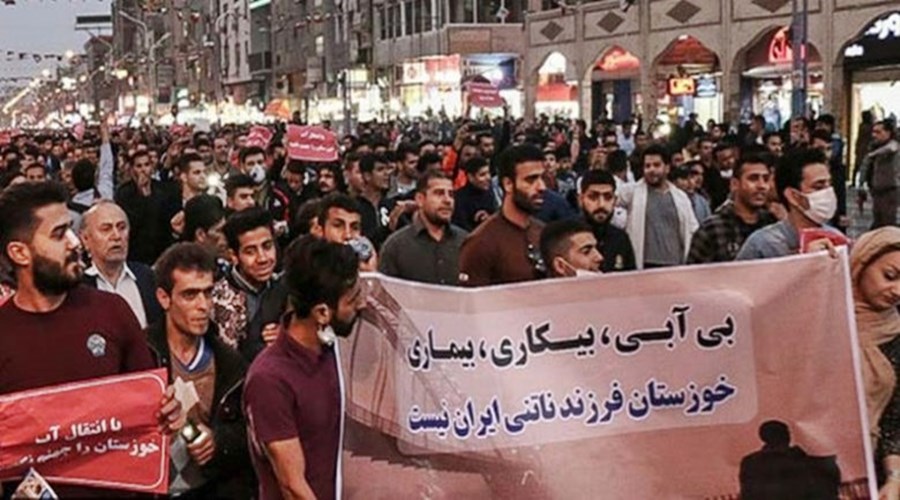Fri 05 June 2020:
The water crisis is worsening in what should naturally be the water-rich Ahwaz region. In the city of Chobeideh, 30 years of acute water shortages have recently been exacerbated. Its residents have to travel 35 km to Abadan city – home to one of the largest oil refineries in the Middle East – simply to purchase water for drinking and washing.
While Abadan has been the source of much of Iran’s exports, its native Ahwazi population have not received any economic benefits from its presence and still lack essential services like running water. They have received nothing from the state except eight years of war against neighbouring Iraq, followed by rounds of displacement without any reconstruction of their destroyed homes and villages.
Likewise, in the nearby rural area of Jafir, Ahwazi residents are suffering from severe water scarcity. On May 30, a group of people from the Bani Saleh district of Neysan in Howeyzeh city blocked the main road leading to a collection of local oil and gas wells and refineries, known collectively as the Jafir oil wells, in protest at the suspension of water services for months.
Dismayed with the state’s neglect of their essential services, protesters have threatened that unless action is taken immediately to rectify the water situation, they will consider sabotaging the oil and gas facilities to prevent staff from working there. Any such actions could potentially disrupt oil production, which serves as the Achille’s Heel of Iran’s embargoed economy. According to the locals, the rural lands possess vast oil-gas fields, yet the Ahwazi villagers do not have access to clean water and essential health services.
The people of the marginalised Jafir rural area, 50 kilometres west of Ahwaz city, told Dur al Untash Studies Centre (DUSC) that although regime officials have visited several times to talk with the local population about the severe hardships they face due to water shortages, especially in the scorching summer heat, they have delivered nothing but empty promises and lies. Instead, their inaction has been underlined by public photo-ops and disingenuous assurances.
Locals also said that they have voiced their discontent repeatedly to staff within the oil and gas companies working in the area, with management officials likewise pledging to resolve the issue without taking any action.
The local Ahwazi population is denied its most foundational rights, with the Iranian regime even reserving jobs at the oil and gas refineries on their land to those identifying as ethnic Persians, most of whom are incomers brought to the region by the Iranian regime. These workers are given homes in ethnically homogeneous settlements and provided with facilities not available to the locals. This has led to the bleak observation, common amongst Ahwazis, that while the regime’s elite in Tehran reaps the financial benefits, all they have received from the vast oil and gas resources situated on their ancestral lands is pollution and disease.
For more than ten years, local people have complained of water shortages, adding that when water is available, it is mostly foul-tasting – acrid and saline in summer, and discoloured, muddy, and foul-smelling in winter.
MPs have frequently raised the subject of the water scarcity in parliament, and it has even been covered in the media. However, it is still unclear how long the Ahwazi inhabitants, whose province is renowned for its great water and energy resources, must wait for healthy water.
The state of the water supply and of the water and sewage network and infrastructure in Ahwaz is unfit for use. Most of the dilapidated network routinely breaks down due to disrepair. It is insufficient to cope with the population growth since it was first installed decades ago.
These problems have led not only to shortages of drinking water, but to several epidemics of previously eradicated diseases like Hepatitis A, Shigellosis, Salmonellosis and Typhoid, transmitted via organisms in the polluted and untreated water reservoirs. On one occasion, in 2018, more than 180 residents of a village in the region were poisoned by drinking contaminated water.
Speaking about the protest on condition of anonymity, one local protester said, “we are disappointed with the authorities’ hollow promises, and we see no solution other than closing the road leading to the oil companies.” Although the area, where temperatures routinely exceed 120 Fahrenheit in summer, is dotted with massive oil and gas fields and refineries, producing over 50,000 barrels of oil and more than 6.5 million cubic metres of natural gas daily, the indigenous Ahwazi people live in abject poverty. None of the local Ahwazi population reaps the benefits of the immense detailed mineral wealth in the region (which houses more than 95% of the oil and gas resources claimed by Iran). The Iranian authorities monopolise control over these reserves.
Think your friends would be interested? Share this story!





